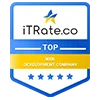
Wearables have been a part of our lives and a vital aspect of the digital transition. When the first digital hearing aids were introduced in the 1980s, no one could have predicted that they would become such an integral part of our daily lives. In the present day, resource-consuming AI app in the fitness business is enabling better exercises without the use of gym equipment through the use of AI devices that assist tailor your fitness goals.
Wearables can also evaluate collected data and send notifications to users. Wearables can also provide augmented services such as hearing or sight enhancements, accessibility features such as voice messaging or sight controlled computer access, environmental features such as air quality warnings or virus contact tracing, virtual travel and game experiences, plus control games, offer warming or cooling through clothing, and even monitor diseases and help prevent falls.
Quick Navigation
What is Wearable API
A Wearable API is an Application Programming Interface that developers can use to integrate wearable device functions into their apps or to retrieve data from wearable devices.
The Wearable category in the ProgrammableWeb directory is the ideal location to look for these trends in AI applications.
Benefits of wearable devices with AI capabilities
Increasing the Effectiveness of Augmented and Virtual Reality
The function of virtual reality and wearable technology in healthcare is already well established in the industry. However, there is a need to make them intelligent.
The implementation of wearable AI in the AR/VR segment was the first and most prominent use case of wearable AI. The use of AI-powered device technology in the wearable industry can considerably improve mixed reality devices, which use a combination of augmented and virtual reality. To function, current mixed reality headsets must be connected to either a powerful PC or a smartphone. However, their performance is limited by the processor's power.
Wearable Intelligence Assistant
With the rise of wearable technology applications, artificial intelligence gadgets are becoming genuine assistants, increasing the consumer experience. The use case of AI Analytics in Wearable is fairly obvious in the sports world, where gadgets and advanced sensors are embedded in smart apparel and provide users with real-time notification of their metrics, as well as actionable advice for improving performance and insights for reducing the risk of injuries. An understandable example is an artificial intelligence smartwatch.
Aside from the sports industry, it is also observed in event and travel use cases, where users are advised of their flight times or movie schedule.
Safety and Health
The most sought-after AI and wearable technology use cases are in healthcare. On an individual level, both technologies – AI in Healthcare and Wearable in Healthcare – are working hard to disrupt the industry. There are numerous ways that the marriage of AI and Wearable is making the healthcare industry more responsive and preventative.
Through natural language processing and computer vision, the system learns the visual signals that sighted people identify in cities, such as paths, buildings, walkways, and curbs. It then employs the data by translating it into natural audio signals that assist visually challenged wearers in moving about the city with ease.
Machine Learning and wearable devices can assist in learning all seizure patterns through real-time monitoring. These wearable gadgets with AI capabilities can be worn by someone with epilepsy and will inform them if a pattern is spotted, giving them enough time to pull over or find a safe area.
Meaningful data can be generated by monitoring the physiological markers of stresses and emotional arousal in children with autism spectrum disorder using machine learning technologies. This, in turn, can assist caregivers in identifying potential precursors, making the health and care domain much more preventive with the advent of Wearables and AI in a healthcare solution providers.
Opportunities and challenges in wearable devices
Life of the battery:
Managing the battery life was a critical issue area for us throughout the AI project management cycle throughout the development and evaluation of wearable fitness devices. Because the processing power of AI wearables is substantially lower than that of smartphones, the batteries tend to run out much sooner than is optimal. To combat this, we took two techniques in our wearable technology development process: First is, we processed only the data that we needed through edge computing, and second is, we streamlined our code to enable limited consumption.
Privacy:
A large amount of data is required for the successful implementation of Artificial Intelligence Wearables. It is critical in this situation to retain privacy as the priority. Throughout the development process, we had to continually question ourselves if we needed to capture specific information. The next step was to compute the derived data on the fly. All of these steps tend to raise the cost of wearable app development services significantly, which might be concerning for startup entrepreneurs.
Security:
Some AI-enabled wearable devices are security-sensitive, such as those that use wearable cameras for facial recognition. Our emphasis for such devices has been to employ on-device data processing in our wearable app development methods. Edge computing eliminates the need to send data through public or private cloud services. This avoidance provides a great degree of privacy. However, when data transmission is required, we use methods to encrypt the data in its entirety.
Summary
In brief, wearable devices backed by the artificial intelligence wearable market are assisting organizations in expanding into new areas of digitalization while also improving lives and ROI. Industries and domains all around the world have already begun to delve deeper into AI innovation. If you have a brilliant idea, start looking for an experienced wearable app development business to assist you in estimating the costs. Also, you can hire wearable device app Development Company for the growth of your device.















